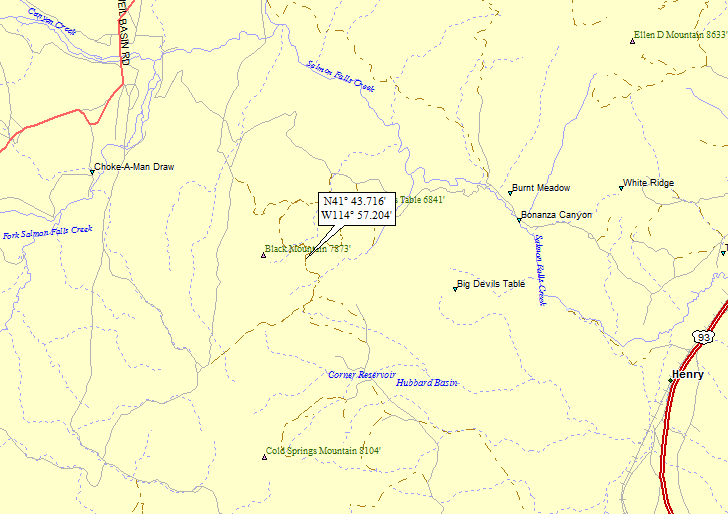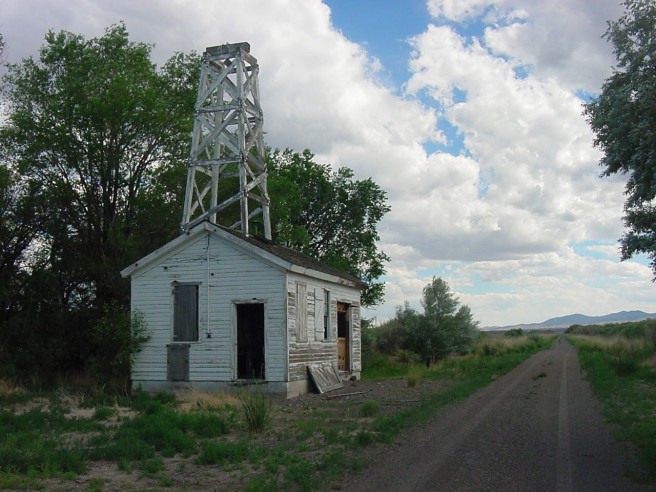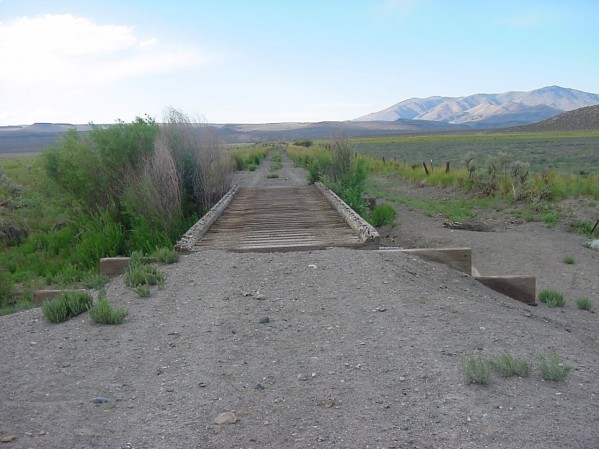Contact and Henry, Nevada
Posted by graywacke on February 13, 2011
First timer? In this formerly once-a-day blog (then every-other-day blog and now a one-to-three-times a week blog), I have my computer select a random latitude and longitude that puts me somewhere in the continental United States (the lower 48). I call this “landing.” I keep track of the watersheds I land in, as well as the town I land near. I do some internet research to hopefully find something of interest about my landing location. To find out more about A Landing A Day (like who “Dan” is and what the various numbers and abbreviations mean), please see “About Landing,” (and “Abbreviations” and “Cryptic Numbers”) above.
Dan – Well, after five USers in a row, I shouldn’t be too greedy. I am allowed to be a little frustrated, though, because I missed a solid USer (ID) by a measly 18 miles, as I landed in . . . NV; 76/70; 6/10; 4; 154.6.
Here’s my landing map, showing my proximity to Contact & Henry:
Here’s a broader view:
I landed in the Devil Ck watershed. This is only my second “devil” – ish watershed, with Devil Ck joining UT’s Dirty Devil River. Devil Ck flows to the Salmon Falls Ck which flows to the Snake R (71st hit); on to the mighty Columbia (138th hit).
Here’s my GE shot, showing a stream-carved very empty landscape:
Backing up a little for a broader view, it looks like I landed in a beautifully-diverse western landscape:
Here’s an oblique GE view (looking west):
Going back to my landing map, I’ll provide a closer-in view:
Note “Choke-A-Man Draw,” just west of my landing. Of course, I Googled it, and was excited to see a Google book come up entitled “Nevada Place Names.” With great anticipation, I began scrolling down through the alphabet. I got to “Chief,” but then was appalled to see that the next entry was “Claim Canyon.” What the heck happened to “Choke”?????? Then I noticed this cryptic little note after the “Chief” entry: “Pages 76 to 77 not shown in this preview.” Are you kidding me???? Does this represent a conspiracy against ALAD???
If any reader knows the scoop on the name “Choke-A-Man Draw,” please comment . . .
Anyway, moving along to Contact. I found out (from Howard Hickson, see below) that Contact was named after a geologic contact between granite and porphory. Porphory is an igneous rock with large crystals; I assume that mine-able minerals were present along this contact.
From OutbackNevada, I found a series of Howard Hickson’s Histories, including this one, “New Teacher in Town.” It provides a great overview of Contact, plus includes some interesting tidbits about moonshiners along with a nice human interest story about (you guessed it), the new teacher in town. This is way longer than my usual cut and paste selections, but I really enjoyed the read:
New Teacher in Town
Contact, Nevada (1933-1934)
In 1933, Marguerite Patterson Evans wrote to her sister-in-law, Edna Patterson, that Contact consisted of two general stores, a crude family hotel, two saloons, a post office, elementary school building, and a high school occupying an old pool hall. She noted there were four regular salaries in town: three teachers and a highway maintenance man. Most of the 100 townspeople relied on welfare to make ends meet. Marguerite was the newly appointed high school principal and teacher.
When she arrived, poor times were haunting the town and its residents. Stagnation and sluggishness had come to Contact hand in hand with the Great Depression.
Contact is some 15 miles south of the Idaho border and 50 miles north of Wells, Nevada, on US Highway 93. Today, a few crumbling buildings, makeshift houses, house trailers and a sparse number of people are all that is left of the little mining camp that tenaciously lived through more busts than booms.
Although gold and silver were discovered in the 1870s, nothing much happened in the way of unearthing riches except during the district’s two production peaks. The first was from 1916 to 1918 followed by another from 1942 to 1946. Both were during times when the United States was at war and large amounts of copper were required for the war efforts.
For those who treasure statistics, Contact produced 742 ounces of gold, 58,713 ounces of silver, 3,343,845 pounds of copper, 324,233 pound of lead, and18,400 pounds of zinc for a total of $702,760. Of Elko County’s 34 mining districts, Contact ranked 12th in overall production. The place even supported a weekly newspaper, The Contact Miner, for a time.
Between start and stop mining operations, other entrepreneurial activities occupied the local breadwinners. In 1979, an article in the Los Angeles Times claims that the town was, during Prohibition, the chief supplier of bootleg whiskey for Idaho.
At a town reunion that same year, Virgil Church, a former resident said, “There were six major moonshine operations in Contact from 1917 until the repeal of Prohibition in 1932. Those were just the big outfits. I was a moonshiner. Hell, everybody in town was a moonshiner making grain whiskey in their cellars. Dad rolled into town in 1912 in a brand new Ford Motel T with Mom and 11 kids. He raised us in Contact with money he made bootlegging.”
John Detweiler added, “My father was justice of the peace here for years. He was never a bootlegger or moonshiner. Said he couldn’t risk the chance, said they’d throw away the keys to the jailhouse if the judge was ever arrested. But hell, he was the Number One supplier of everything needed to make whiskey. Dad hauled in all the coal, barrels, wheat and sugar to supply the moonshiners.”
Detweiler said his father, the justice, had the slot machine concession in town. “He would always take me with him when he collected money from the slots at Hard Rock Tilly’s sporting house at the south end of town. As long as I was with him, Mother figured Dad wouldn’t get in any trouble there.”
When Prohibition ended so did another Contact boom. Life was again tough on the people. Marguerite came to town after Prohibition ended and Contact residents were mostly destitute. Her female students wore threadbare, patched dresses. She wrote: “I hung my prize ribbons in my front room to impress my sewing class. I am at least going to teach these girls how to handle a pattern and make simple dresses. None of the families have enough money to buy patterns and material for sewing so I went down to Elko to see what I could do for aid. I went to the Red Cross and requested enough material for underwear and three dresses for each girl. The girls are so thrilled that I have a difficult time sending them home after school.”
Marguerite wrestled with another problem. Daisy, a local baker, couldn’t pass her Wasserman test for syphilis. It was common knowledge that Daisy was generous with her affections but Marguerite decided she would have to do something more serious than eat Daisy’s cooking to be contaminated.
There was no doctor in town. In March1934, Marguerite and the other teachers dealt with epidemics of measles, scarlet fever, impetigo, streptococcus throat, and flu. Once, when she needed to take the temperature of a little boy, she had to borrow a thermometer. She hiked down to a local saloon for some 100-proof whiskey. The thermometer was dipped in the booze and Marguerite hoped that few germs would survive the ordeal.
In her last letter from Contact: “Entertainment is in the Community Social Hall. The hall is the pride of the town with walls covered with lurid murals of the Contact that might have been – according to the dream of the men who raised money to build this substantial concrete building.”
Years passed. Dreams died. Yet, there are still people living in Contact. I guess it can’t be called a ghost town yet.
Marguerite Evans left Contact after her first year there. In her long career she taught at Montello, Halleck, White Pine High School in Ely, and was the librarian at Elko High School. During World War II she was director of the Enlisted Men’s Club at the Army Air Force Base at Wendover, Utah, where the atomic bomb crews were trained. She retired in the 1950s. Born in 1901, she died in Elko in 1985.
Howard Hickson
April 6, 2002
Here’s a picture from the same website, showing some of the miner’s houses:
Here’s a recent shot from Contact by Randy Hale that I found on the UNLV Library website:
I found this about Henry on Elkrose.com, about Elko County ghosttowns:
Henry was a depot and water station on the Oregon Short Line. The station came into being in late 1925 and was named after Henry Harris, a popular negro foreman for the Sparks-Harrell cattle empire. Harris had come from Texas and served as a cook for Nevada Governor John Sparks. After moving to Elko County, he became respected and admired for his knowledge of the cattle industry.
A couple of ranches operated near Henry and utilized the depot for shipping cattle. Because of the number of children on the nearby ranches, a school operated at Henry during the 1930s and 1940s. By time the Oregon Shortline ended operations and pulled up its rails in 1978, the area was empty. The small depot, adjoined by the water pump and tower, remain today amid a stand of trees.
From the same website, here’s a picture of the Henry train depot:
I’ll close with this cool shot of an abandoned railroad bridge:
That’ll do it. . .
KS
Greg
© 2011 A Landing A Day










Jon Byrnes said
This was a particularly interesting read for me. My grandmother, Mary Annette Chapman, was a teacher for one year in Henry around 1929-1930.
graywacke said
Jon – I’m glad you enjoyed it. Thanks for visiting . . .
Greg
kelly said
My Grandma Lois grew up in Contact Nevada her parents owned the miner houses . Governor Pat Mccarren use to stay there when he would buy whiskey from my Great grandfather Louis Pratt he also owned Heavens Heights a speak easy
graywacke said
Kelly – Thanks for the local color! I always like it when a local reads one of my posts and can add some personal stories.
Greg